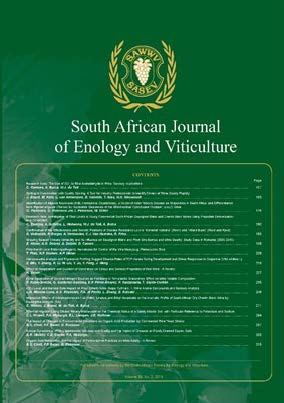Potential of Local Entomopathogenic Nematodes for Control of the Vine Mealybug, Planococcus ficus
DOI:
https://doi.org/10.21548/39-2-3158Abstract
Planococcus ficus, the vine mealybug, is the dominant mealybug pest of grapes in South Africa. To provide an alternative for chemical control, entomopathogenic nematodes (EPNs) were investigated as a biological control agent to be used in an integrated pest management system. Four local EPN species were screened for efficacy against female P. ficus, the most potent of which were Heterorhabditis noenieputensis, with 90% mortality, and Steinernema yirgalemense, with 63%. Since S. yirgalemense was previously shown to be highly effective against a range of pests, the effects of temperature and humidity on the infectivity of S. yirgalemense to female P. ficus were also assessed. The application of S. yirgalemense at 25°C yielded the highest mortality, of 72%, followed by 45% mortality at 30°C, and only 9% mortality when applied at 15°C. Steinernema yirgalemense performed best at 100% relative humidity (RH), resulting in 70% mortality. Decreasing RH levels resulted in decreased mortality (61% mortality at 80% RH, 40% mortality at 60% RH). As a soil-based organism, S. yirgalemense is most effective as a biocontrol agent of P. ficus under conditions of moderate temperature and high humidity. Its lethality to P. ficus, and its status as an indigenous species, indicate its promise as a potential biocontrol agent of the vine mealybug.Downloads
Downloads
Published
Issue
Section
License
A copyright form will be e-mailed to the corresponding author when the manuscript has been accepted for publication.
In principle, the Author agrees to the following when he/she signes the copyright agreement:
I hereby assign to the SOUTH AFRICAN SOCIETY FOR ENOLOGY AND VITICULTURE (SASEV) the copyright of the text, tables, figures, supplementary material, illustrations and other information (the Material) submitted with the manuscript to be published in SOUTH AFRICAN JOURNAL OF ENOLOGY AND VITICULTURE (SAJEV) (the "Article"). The copyright becomes effective from the date the Article has been accepted for publication in SAJEV.
This is an open access journal, and the authors and journal should be properly acknowledged, when works are cited.
Author's may use the publishers version for teaching purposes, in books, theses, dissertations, conferences and conference papers.
A copy of the authors' publishers version may also be hosted on the following websites:
- Non-commercial personal webpage or blog.
- Institutional webpage.
- Authors Institutional Repository.
The following notice should accompany such a posting on the website: This is an electronic version of an article published in SAJEV, Volume XXX, number XXX, pages XXX - XXX, DOI. Authors should also supply a hyperlink to the original paper or indicate where the original paper (www.journals.ac.za/index.php/sajev/) may be found.
Authors publishers version, affiliated with the Stellenbosch University will be automatically deposited in the University's Institutional Repository SUNScholar.
Articles as a whole, may not be re-published with another journal.
The following license applies:
Attribution CC BY-NC-ND 4.0

